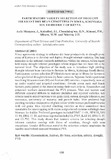| dc.contributor.author | Nderitu, J. H. | |
| dc.contributor.author | Mburu, M. W. | |
| dc.contributor.author | Kimani, P. M. | |
| dc.contributor.author | Chemining'wa, G.N. | |
| dc.contributor.author | Kabutbei, J. I. | |
| dc.contributor.author | Aufa Munyasa, J. | |
| dc.date.accessioned | 2014-07-21T12:52:09Z | |
| dc.date.available | 2014-07-21T12:52:09Z | |
| dc.date.issued | 2011-09 | |
| dc.identifier.citation | Optimimization of Agricultural Value Chains for sustainable Development | en_US |
| dc.identifier.uri | http://hdl.handle.net/11295/73210 | |
| dc.description | aGRO 2011 Biennial Conference presentation | en_US |
| dc.description.abstract | A key agronomic strategy to enhance dry bean productivity in drought prone
areas of Kenya is to develop and deploy drought tolerant varieties. Dry bean
nurseries in the national research institutions within the eastern Africa region
hold many drought tolerant genotypes whose impact has not been felt at the
national level. The objective of the study was to introduce high yielding,
drought tolerant bean varieties to farmers in Mwea, Kirinyaga South district.
Participatory variety selection (PVS) trials were set up in Mwea for farmers to
select preferred drought tolerant dry bean varieties. Separate field experiments
involving Mesoamerican (84) andAndean (88) varieties, respectively, were set
up under rainfed and irrigated conditions. Twenty seven male and female
farmers participated in the exercise using their own criteria. Researchers and
extension workers demonstrated the PVS process. Men and women used
different coloured ribbons to indicate preferred and rejected varieties. Key
criteria used to select varieties were grain yield, colour, drought tolerance, pest
resistance, uniformity of maturity and growth habit. Men preferred high
yielding varieties irrespective of grain colour while women preferred varieties
with red grain. Men rejected climbing varieties as they considered them
unsuitable for intercropping with maize and preferred varieties with high shoot
biomass for fodder. Preferred genotypes included DMC 11-11, SEN 53, DSS
11-08, DRK 11-18, and those rejected included GLP585, KATBl, DSS 11-03,
and GLP92. This study shows that farmers' criteria for selecting drought
tolerant varieties overlap with those of scientists, though with some
exceptions. Gender differences noted in the selection criteria emphasize the
need to involve both men and women in PVS. | en_US |
| dc.description.sponsorship | National Council of Science and Technology, The Kenya Seed Company | en_US |
| dc.language.iso | en | en_US |
| dc.publisher | Faculty of Veterinary Medicine, University of Nairobi | en_US |
| dc.subject | PVS | en_US |
| dc.subject | drought, | en_US |
| dc.subject | criteria, | en_US |
| dc.subject | selection, | en_US |
| dc.subject | dry bean, | en_US |
| dc.subject | Andean, | en_US |
| dc.subject | Mesoamerican, | en_US |
| dc.title | Participatory variety selection of drought tolerant dry bean genotypes in Mwea, Kirinyaga south district of Kenya | en_US |
| dc.type | Presentation | en_US |
| dc.type.material | en | en_US |

